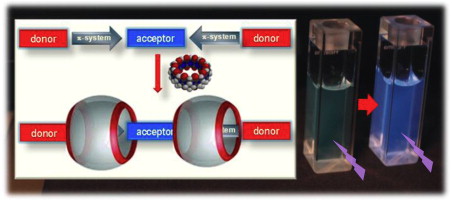Publications > Carmona et al
Cucurbit[n]urils as a potential fine-tuned instrument for modifying photophysical properties of D–π–A+–π–D “push–pull” chromophores.
1. Departamento de Química Analítica, Química Física e Ingeniería Química, Universidad de Alcalá, 28871 Alcalá de Henares, Madrid, Spain. 2. Departamento de Química Orgánica y Química Inorgánica, Universidad de Alcalá, 28871 Alcalá de Henares, Madrid, Spain.
Abstract
Photophysical properties of supramolecular complexes between cucurbit[7]uril (CB[7]) and one- (1D, linear) and two-dimensional (2D, V-shaped) D–π–A+–π–D pyridinium (A+) based “push–pull” chromophores, were investigated by UV–Vis and fluorescence techniques, as well as Molecular Mechanics and Molecular Dynamics simulations. Both chromophores formed stable complexes with CB[7] of different stoichiometries. Complexation was accompanied by significant changes in the photophysical properties of the guests: (i) bathochromic shifts for the π–π* charge transfer absorption band, which is more evident for the 1D than for the V-shaped one, (ii) significant enhancement of the fluorescence intensity, (iii) displacement to the blue of the emission and (iv) change in their fluorescence lifetimes, which is more patent for the V-shaped one. 1D chromophore/CB[7] complex formation was both enthalpically and entropically favored, whereas inclusion of the V-shaped one, accompanied by a little positive enthalpy change, was entropically governed. Variation of fluorescence lifetime and fluorescence anisotropy upon complexation exhibited quite different behaviors. MM and MD calculations were performed to simulate the complexation processes in the presence of water, determine their preferred structures and establish the host:guest interactions responsible for the complexes formation which were preferentially electrostatics.

